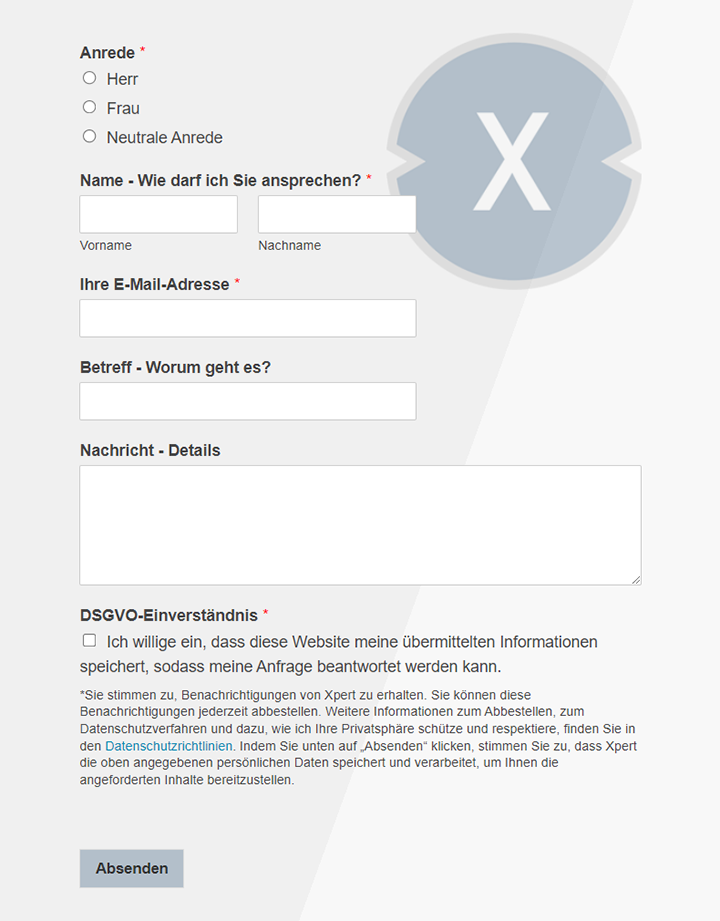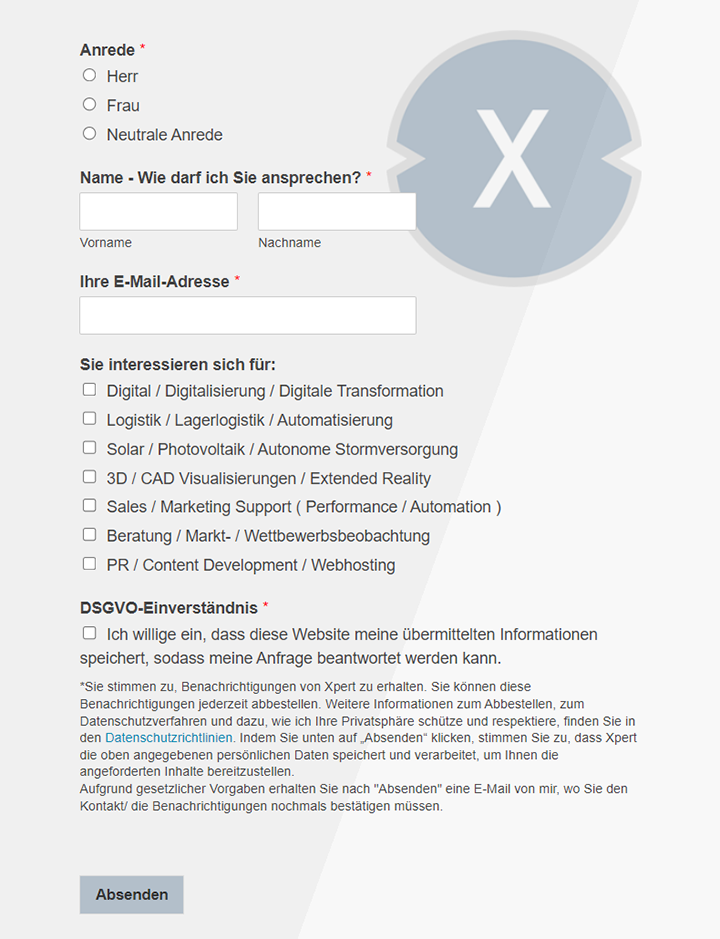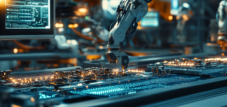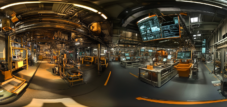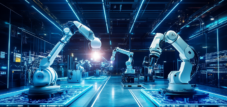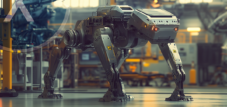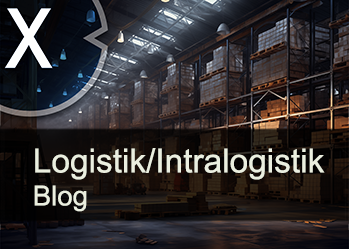The traveler (mobile) cobot and its advantages over traditional industrial robots
Xpert pre-release
Language selection 📢
Published on: February 1, 2025 / update from: February 1, 2025 - Author: Konrad Wolfenstein

The traveler (mobile) cobot and its advantages over traditional industrial robots - picture: xpert.digital
Colleague Robot: What mobile cobots can do for your production
Industry 4.0 on the pulse of time: Mobile cobots in use
Mobile cobots (collaborative robots) combine the autonomy of mobile platforms with the precision and versatility of robotic arms in order to take on demanding tasks in flexible production environments. These innovative systems change industrial automation by enabling seamless interaction between man and machine. Whether material transport, machine assembly or quality control - mobile cobots offer a solution for numerous challenges of modern production.
Beat functions of modern mobile cobots
Modern mobile cobots have a variety of innovative technologies that make them powerful tools in industry:
- Autonomous navigation using 2D/3D sensors (e.g. security laser scanners, cameras) for obstacle recognition and route planning.
- Collaborative robot arms with loads of up to 10 kg, equipped with modern gripping systems and sensors.
- Easy integration into existing IT systems such as ERP and MES systems using wireless interfaces.
- All-round-the-clock operation through automatic charging stations and inductive charging.
Scope:
- Materialogistics
- Production support
- quality assurance
Examples:
- Part transport between stations, palletry
- Machine exposure, assembly
- Vehicle inspection, optical examination
Industry:
- Automotive, Pharma
- Electronics, metal
- Automotive, aviation
Market -leading models and manufacturers
Some of the leading mobile cobots and their respective properties are:
- Omron MoMA: A combination of the mobile LD platform and the TM robot arm, optimized for pick-and-place tasks in the electronics and pharmaceutical industry.
- KMR IISY from KUKA: An MRK-capable (human-robot collaboration) of autonomous mobile robots (AMR) with 3D cameras and security lasers for automated vehicle production.
- Rebel-Cobot series from IGUS: A cost-effective solution (from € 10,000) for small and medium-sized companies with slam-based navigation.
Suitable for:
Advantages over inpatient systems
- Reduced downtimes: With quick adaptation to new production layouts, downtimes can be reduced by up to 70 %.
- Higher area efficiency: ShareD workplace concepts optimize the use of the available area by up to 30 %.
- Security and compliance: compliant with ISO/TS 15066 for safe human-robot collaboration.
With AI-based image processing, modern mobile cobots can now also take on visually complex tasks such as surface testing or the handling of unsorted parts. This further development makes it central elements of Industry 4.0 and smart factories.
Core advantages of mobile cobots
1. Security and direct human-robot collaboration
- Working without a protective fence: Mobile cobots automatically stop contact with people through modern safety sensors such as power limitation and 3D cameras.
- Physical teamwork: Cobots can interact with people, keep workpieces together or hand over components.
2. Flexibility and mobility
- Autonomous navigation: Slam technology enables precise orientation and movement between work stations.
- Simple implementation at new locations: Mobile Cobots can be flexibly adapted to new tasks and production lines.
- Plug-and-play integration: connection with existing IT systems without complex cabling.
3. Cost efficiency and faster ROI
- Lower acquisition costs: available from around € 10,000.
- Fast amortization: ROI usually within 5 to 18 months.
- Leasing models (Robots-As-A-Service): reduces capital binding and facilitates access to modern robotics.
4. Place optimization
- 30 % lower space requirement due to the elimination of security fences.
- Use in cramped rooms possible, where traditional industrial robots cannot be used.
Strategic advantages for production
- Reduced downtimes due to automatic loads during idle phases.
- Higher surface utilization due to flexible, mobile systems.
- Resilience against personnel bottlenecks: relief for specialists by taking over monotonous tasks.
Limits of technology
Despite their advantages, mobile cobots also have restrictions:
- High -speed applications such as welding with 10 m/s remain the domain of traditional industrial robots.
- High loads over 100 kg are not feasible for cobots.
- Mass production with extremely high throughput continues to require classic industrial robots.
The combination of mobility, security and fast amortization makes mobile cobots a key block for digital transformation in industry. Especially in industries with a high variety of variants such as medical technology or electronics production, they offer significant advantages. With the further development of AI, sensors and cloud -based control systems, mobile cobots will be even more powerful and versatile in the future.
Our recommendation: 🌍 Limitless reach 🔗 Networked 🌐 Multilingual 💪 Strong sales: 💡 Authentic with strategy 🚀 Innovation meets 🧠 Intuition
At a time when a company's digital presence determines its success, the challenge is how to make this presence authentic, individual and far-reaching. Xpert.Digital offers an innovative solution that positions itself as an intersection between an industry hub, a blog and a brand ambassador. It combines the advantages of communication and sales channels in a single platform and enables publication in 18 different languages. The cooperation with partner portals and the possibility of publishing articles on Google News and a press distribution list with around 8,000 journalists and readers maximize the reach and visibility of the content. This represents an essential factor in external sales & marketing (SMarketing).
More about it here:
Mobile Cobots: The future of human-robot collaboration in industrial automation-background analysis
Mobile Cobots: A revolution in modern production
The world of industrial automation is currently experiencing profound change, led by the development and integration of mobile collaborative robots, also known as mobile cobots. These highly developed systems, which combine the flexibility of autonomous mobile platforms with the precision and versatility of robotic arms, enable a new era of human-robot collaboration and open up unpredictable opportunities for the design of efficient and flexible production processes. In contrast to traditional industrial robots, which often operate in rigid and isolated work environments, mobile cobots are designed to work dynamically and safely in the immediate vicinity of people. This ability to adapt to changing tasks and environments makes it an indispensable tool for companies that want to strengthen their competitiveness in an increasingly fast -moving and demanding global economy.
The interaction of mobility and collaboration
The core innovation of mobile cobots lies in its ability to combine two key elements of modern automation: mobility and collaboration. While traditional robots are restricted by their fixed installation and the need for security fences, mobile cobots allow completely new flexibility. You can move autonomously in the production environment, take on tasks at various work stations and adapt to changing production requirements. This is made possible by highly developed navigation systems that are able to record the surroundings and bypass obstacles. At the same time, mobile cobots are equipped with sensors and security mechanisms that allow them to safely work with human employees. By combining these two aspects, mobile cobots enable a more efficient and flexible production method that meets the needs of modern industry.
Technological foundations of mobile cobots
The performance of mobile cobots is based on a number of advanced technologies that interlock seamlessly:
Autonomous navigation
Mobile cobots use a combination of 2D and 3D sensors such as laser scanners, cameras and ultrasonic sensors to map their surroundings and recognize obstacles. With the help of SLAM technology (simultaneous localization and mapping), you are able to locate yourself and plan efficient routes without the need for permanent external control. The ability to adapt to changes in the area in real time is crucial for the flexibility of these systems.
Collaborative robot arms
The robot arms that are mounted on the mobile platforms are specially designed for cooperation with people. They have integrated power and torque sensors that allow them to react to unforeseen contacts with people and to stop their movements immediately. The loads of these arms can vary depending on the model and manufacturer, but are typically in the range of 5 to 15 kg, which makes it ideal for a variety of tasks, such as assembly, material handling and quality control.
Integrated gripping systems
The gripping systems of the cobots are also designed for the flexible handling of different objects. They can be equipped with different graspers, suckers or special tools to perform different tasks. Many systems have a quick change of tools, which also increases the adaptability to different production processes.
Plug-and-play integration
Mobile cobots are usually designed in such a way that they can be seamlessly integrated into existing IT systems such as ERP (Enterprise Resource Planning) and MES (Manufacturing Execution System). This enables easy integration into the existing production infrastructure without complex cabling or programming. Wireless interfaces, such as WLAN or Bluetooth, enable easy communication and data transmission.
24/7 operability
Many mobile cobots are equipped with automatic charging stations or inductive charging systems, which enable them to independently charge the battery without being necessary. This enables continuous 24/7 operation and thus contributes to maximizing production efficiency.
Areas of application: diversity and flexibility
Mobile cobots are used in a variety of industries and application areas, including:
Materialogistics
You can transport materials and components between different work stations, take on picking tasks and even load pallets. In the automotive industry, for example, they transport parts from a warehouse to the assembly line or from one machining machine to the next. They are used in the pharmaceutical sector to move sensitive materials and medication.
Production support
Mobile cobots can be used in assembly, processing and quality control. In the electronics industry, they equip machines with components, carry out assembly work and check the quality of the products. In metal processing, support you in processing workpieces and handling heavy materials.
quality assurance
Mobile cobots can be equipped with cameras and sensors to carry out visual inspections and quality controls. In the automotive industry, for example, you check body parts for defects or survey errors. In aviation, inspect the surfaces of aircraft parts for damage and carry out precise measurements.
Leading models and manufacturers: a selection
The selection of mobile cobots on the market is diverse and grows steadily. Some of the best known models and manufacturers are:
Omron Moma
The OMRON model combines a mobile LD platform with a TM robot arm and is often used in the pharmaceutical and electronics industry for pick-and-place tasks. The integration of intelligent image processing enables the MOMA to also take on complex tasks and achieve a high level of accuracy.
Kmr iisy from Kuka
With the KMR IISY, KUKA offers a mobile, collaborative robot that has 3D cameras and scanners and is used in automotive production for tasks such as automated assembly. The KMR IISY is characterized by its high flexibility and security in working with people.
Rebel-Cobot series from Igus
With the Rebel-Cobot series, Igus offers an inexpensive solution for small and medium-sized companies (SMEs). The cobots are based on slam technology and enable easy integration into existing production environments. Igus focuses on the affordability and easy operation of the cobots.
Suitable for:
Advantages over traditional systems: a paradigm shift
The advantages of mobile cobots compared to traditional industrial robots are diverse and have led to a paradigm shift in industrial automation:
Reduced downtimes
The possibility of making layout changes quickly and easily can be reduced by up to 70% in production changes. The flexibility of mobile cobots enables companies to react quickly to new market conditions or changed customer requests.
Higher area efficiency
Thanks to the possibility of using work areas together, up to 30% of the area can be saved in production facilities. The elimination of security fences and the compact construction of the cobots contribute to optimally using the available space.
Improved workplace safety
Compliance with the ISO/TS 15066 standard for human-robot collaboration guarantees a safe working environment. Due to the integrated security functions and the ability to react to contacts, mobile cobots minimize the risk of injuries and enable direct collaboration with human colleagues.
Core advantages in detail: A look at the most important aspects
Security and direct human-robot collaboration
Mobile cobots can work without the need for protection fences because they are equipped with sophisticated safety sensors. These sensors, including strength boundary systems and 3D cameras, enable the cobots to stop their movements immediately as soon as they detect a collision with a person. This ability to safely interaction allows people and machines to work closely together, for example in the joint handling of workpieces or the handover of components. This creates a harmonious symbiosis in which the strengths of humans and robots can be optimally used.
Flexibility and mobility
Mobile cobots independently navigate between different work stations by using the slam technology to map their surroundings and determine their position. This makes it possible to use them quickly and easily at different locations, which is particularly advantageous for seasonal production peaks or changing production requirements. The plug-and-play integration into existing IT systems simplifies commissioning and reduces the effort for the facility.
Cost efficiency and ROI
The acquisition costs for mobile cobots are usually smaller compared to traditional industrial robots, and Return on Investment (ROI) can be reached in a period of 5 to 18 months. In addition, many manufacturers offer leasing models (Robots-As-A-Service) that enable companies to rent the cobots instead of buying them, which reduces capital loyalty. Due to their flexible usability and their ability to take on different tasks, mobile cobots contribute to reducing operating costs and increasing productivity.
Space optimization
Mobile cobots need significantly less space than conventional robots because they do not need security fences and have a compact design. This is particularly advantageous in cramped production environments. They can be used in places where the use of traditional robots would not be possible due to lack of space. This enables companies to optimally use their existing production areas and to design more efficient work processes.
Comparison with traditional industrial robots: a differentiated look
While mobile cobots have clear advantages in terms of flexibility and security, traditional industrial robots still have their justification in areas where high speeds and heavy loads are required. For example, traditional robots are still used when welding at speeds of up to 10 m/s or when moving more than 100 kg. This means that choosing the right robot depends on the specific requirements and conditions of the respective application.
Strategic advantages for production: shaping the future
The strategic advantages of using mobile cobot in production are diverse:
Reduced downtimes
The automatic charge during the idle phases enables continuous 24/7 operation and ensures maximum utilization of the production capacities. Mobile cobots can be used in a variety of layers without human breaks or working hours restricting productivity.
Higher area utilization
By creating shared workplace concepts with collaborative work cells, the area utilization of production facilities can be optimized. Human employees and robots can share the same work areas and thus work more efficiently together.
Resilience against personnel bottlenecks
The takeover of monotonous and repetitative tasks by mobile cobots, such as the material supply, relieves specialists and enables you to focus on more complex and demanding tasks. This helps companies counter the challenges of the shortage of skilled workers and at the same time secure the productivity and quality of their products.
Limits of technology: realistic expectations
Although mobile cobots offer many advantages, it is important to take their limits into account. While you are superior to flexibility and security, you cannot perform the same performance as traditional industrial robots in terms of speed and load. This means that they are not suitable for certain applications, especially in areas where mass production with high throughput is required. Due to their performance and specialization in certain tasks, traditional robots remain indispensable here.
Mobile cobots as a key technology for Industry 4.0
The combination of mobility, security, flexibility and fast amortization makes mobile cobots a key technology for Industry 4.0. They are particularly attractive for industries with a high variety of variants and dynamic production processes, such as medical technology or electronics production. Through their ability to adapt to changing requirements, they enable companies to become more efficient, more flexible and competitive. Mobile cobots are not only a technological innovation, but also change the way people and robots work together in production. You are the pioneer for a new era of intelligent automation and will have an ever greater impact on the design of global industry in the coming years. The future factory will thus be shaped by the cooperation between people and mobile robotics to ensure efficient, dynamic and resilient production.
We are there for you - advice - planning - implementation - project management
☑️ SME support in strategy, consulting, planning and implementation
☑️ Creation or realignment of the digital strategy and digitalization
☑️ Expansion and optimization of international sales processes
☑️ Global & Digital B2B trading platforms
☑️ Pioneer Business Development
I would be happy to serve as your personal advisor.
You can contact me by filling out the contact form below or simply call me on +49 89 89 674 804 (Munich) .
I'm looking forward to our joint project.
Xpert.Digital - Konrad Wolfenstein
Xpert.Digital is a hub for industry with a focus on digitalization, mechanical engineering, logistics/intralogistics and photovoltaics.
With our 360° business development solution, we support well-known companies from new business to after sales.
Market intelligence, smarketing, marketing automation, content development, PR, mail campaigns, personalized social media and lead nurturing are part of our digital tools.
You can find out more at: www.xpert.digital - www.xpert.solar - www.xpert.plus





